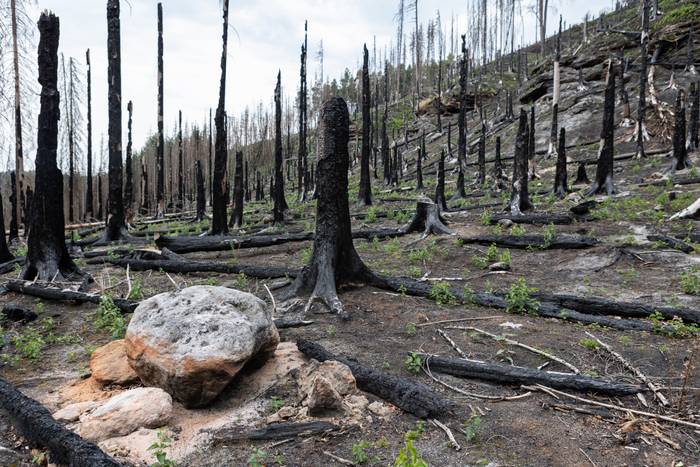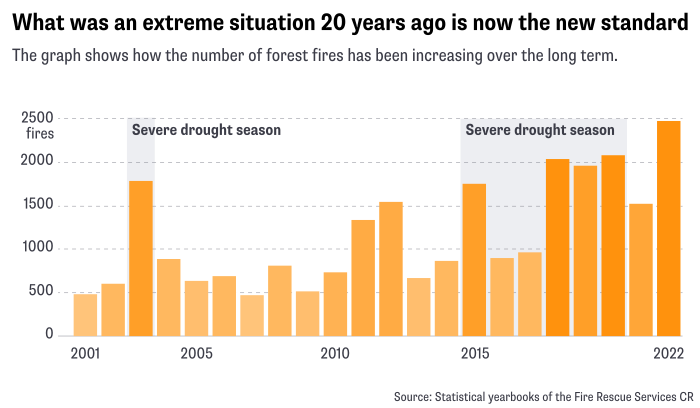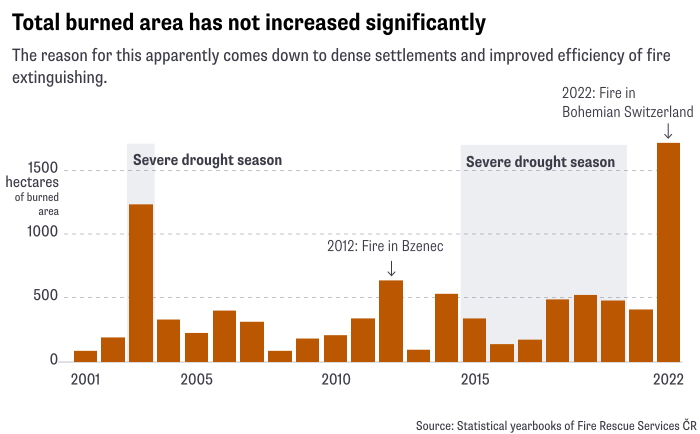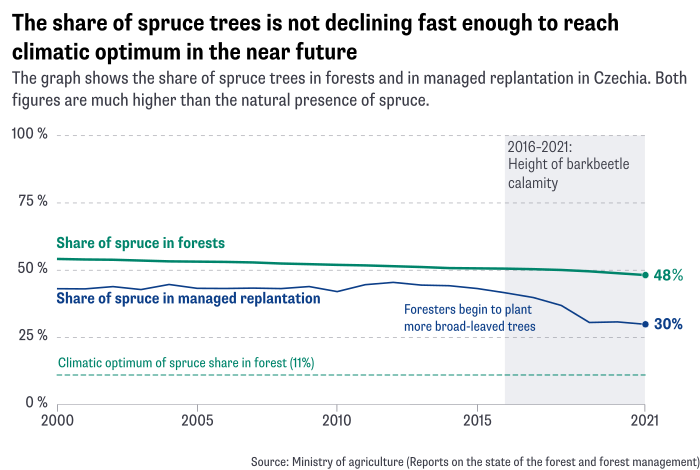Forest fires are on the rise in Czechia as in the rest of the world: timely action is needed
The high number of highly flammable spruce monocultures in Czechia is mainly due to conservative forestry and poorly framed legislation. But while the climate is already shifting, the laws that are holding back forest conversion have remained unchanged on the books for decades.

Photo by Peter Tkáč, Deník Referendum
Forest fires are a growing problem for much of the world. According to a United Nations report published last year, the number of extreme forest fires worldwide will rise by 50 percent by the end of the century. The causes are mainly climate change and human management of the land.
The Czech Republic will not escape this problem either. We can already see, from data from the Fire Brigade of the Czech Republic, that forest fires have increased significantly since the beginning of the century in the country. The dry year of 2003, for example, was an extreme year in terms of the number of fires, which reached over 1,700. Only a year earlier, in comparison, there were 600. However, the number of fires that burned in 2003 is closer to the new norm.
“The number of forest fires has increased significantly over the last twenty years and will continue to grow,” confirms Petr Čermák from the Faculty of Forestry and Wood Technology at Mendel University.

What is not increasing in the long term, unlike the number of fires, is the size of the areas burned. According to Čermák, this is mainly due to the good network of forest roads and high population density of the country. Fires are usually quickly spotted and extinguished in time – and they are kept small.
According to Martina Götzová, a spokeswoman for the Czech Fire and Rescue Service, increasingly better firefighting equipment is also contributing to stamping out the fires swiftly.
In recent years, there have been only two major forest fires that got out of control. The first was the 2012 fire in Bzenec in southern Moravia, and the second was last year’s fire in Czech Switzerland, a nature reserve in the Elbe Sandstone Mountains in northwestern Czechia. In both cases, the burns that whipped over such large areas were helped by dry sandy subsoils and large stands of extremely flammable trees: pines in Bzenec, pines and spruce in the nature reserve. In the second fire, the difficult terrain also made the fires harder to reach and fight.

Experts agree that there will be more and more such large fires as climate change continues.
“Greater extremes are on the way,” says biologist Ondřej Sedláček from the Faculty of Science at Charles University. “For example, there’ll be longer droughts, heat waves and stronger winds. We can therefore expect that the climatic conditions for sparking and fanning forest fires will be greater. In the Czech lands,” he adds, “we’ll see phenomena that we used to see mainly in the Mediterranean.” Čermák agrees. “There will be more and more situations like the one in Czech Switzerland.”
In face of the growing forest fires, nonetheless, the Czech Republic continues to carry on with its long-standing poor forest management practices, namely the overplanting of spruce monocultures. Spruce trees are themselves extremely flammable due to their high resin content.
According to the State of the Forest Report 2021, published by the Ministry of Agriculture, spruces occupy almost half of the forest area in Czechia. Yet if spruces grew only in places where they are at their climatic optimum – i.e., where they grow naturally – they would take up only 11% of the forest area, the report states.
The true percentage of the area that is natural for spruce, however, is probably even smaller. “This assumption of natural spruce cover was made in the last century, and that assumption has become outdated. Since that era, climate change has shrunken the number of sites where spruce grow naturally even further,” explains Jan Skalík from the ‘Zachraňme lesy’ (‘Let’s save the forests’) initiative, which is part of the environmental organisation Hnutí Duha (‘Friends of the Earth Czech Republic’).
For spruce, a wetter climate at higher altitudes is ideal – particularly in Sumava or the Giant Mountains.
When the spruce wheat continues to fail to bloom
Half of the forest cover in the Czech Republic is a legacy of forestry practices that date back to the 18th and 19th centuries. (We went into this in more detail in the previous text of this series, the report from Czech Switzerland.)
Although there is now a scientific consensus that spruce poses a serious problem, the situation is changing only slowly. Foresters are still planting spruce even in lowland and dry areas – that is, in places with a higher risk of fires. In addition, climate change is shrinking the area of suitable sites and increasing the areas at increased risk of fire.
According to Sedláček, spruce should not grow at all in areas at increased risk of fire. These are mainly lowlands, areas with dry undergrowth and bracken – a mixture of dead needles and twigs – and places with terrain difficult to get to. “In those places where we have planted spruce and where it doesn’t belong, and especially in flammable areas and sites where it lies completely outside its climatic optimum, I would strip it away completely,” Sedláček says, adding that he would replace it primarily with deciduous trees such as oak or beech.
These deciduous trees are more natural for the habitat, but they are also significantly less flammable. “Beech is an excellent slower of fires,” Sedláček explains. “From paleoecological studies that investigate forest fires thousands of years in the past, we know that once beech took over an area, fires stopped. But beech is also more of a species for higher altitudes. In the lowlands, it should be mostly oaks or maples. But there are many other suitable tree species as well.”
Today, the Ministry of Agriculture recommends cutting spruce back to twenty-eight percent of the total area of Czech forests. Yet even this is at least seventeen percentage points above the area that lies with the aforementioned climate optimum.
Jan Skalík of the Duha movement argues that the minister’s recommendation does not correspond to models that predict that climate change is here for the long term. “It’s not possible to come up with a specific target proportion of trees that would be optimal for the next tens or hundreds of years,” he explains. There is already a need now, he says, to create forests that are diverse enough in species and ages to withstand the full range of potential climate changes – either warming or, conversely, a fall in temperature due to the cooling of the Gulf Stream.
How to get rid of them
The massive bark beetle calamity, which afflicted Czech spruce forests mostly between 2016 and 2021, slightly accelerated the decline in spruce coverage, as spruces were dying all over the country. The situation was particularly extreme in northern Moravia, Vysočina and northern Bohemia. Despite that die-back, the proportion of spruce forests has fallen by only six percentage points over the last twenty years.
A swifter decline in the number of spruce trees was not really encouraged by foresters planting more deciduous trees, and therefore fewer spruce trees, in response to the bark beetle. “The reason is that only a small part of the total forest area is ever regenerated,” Čermák explains. “And only in that area do you have a chance to make a difference. So the pace is really slow, and a significant change in species composition is a task for decades.”

Not long ago, it seemed that the bark beetles would force a fall over the long term in the number of spruce trees planted. But as the graph shows, the decline stopped in 2019, and everything seems to be reverting to the way it was. “The topic of species composition is no longer as urgent as it was at the outbreak of the bark beetle infestation, and forest owners are no longer under public scrutiny about what and how they plant,” says Skalík, himself a small forest owner.
The recent bark beetle calamity was also far being from the last, according to Jaromír Bláha. “Another wave of bark beetles is expected. It’ll probably return with the next drought, or if strong windstorms tear through the forests. Bark beetle multiplies faster on such wood.”
Waiting for more bark beetle outbreaks to reduce the spruce coverage again is no solution, he warns. “Many experts agree that rather than waiting to eliminate such infestations after they have happened, more resources should be devoted to converting existing spruce forests into mixed forests before they happen. This could be done by replanting.”
In practice, such a conversion would mean cutting down some of the trees in the spruce forests to allow more light into the forest, and then seeding other tree species among the spruces.
Another possible solution, which ecologists have long called for, is so-called natural regeneration – that is, creating a forest with the help of aerial seeding. Ondřej Sedláček is convinced that such a forest would be more diverse in age and species than spruce monocultures, and that would make it more resilient.
A scarecrow named clear-cutting
Forests are vulnerable to fire not only because spruce are growing in unsuitable locations, though, but also because of other risk factors associated how the spruce is grown.
One of the biggest problems is so-called clear-cutting—that is, cutting down all the trees in a forest, which strips the forest floor bare and exposes it to the harsh effects of sunlight. It is in spruce groves that fires spread particularly quickly, as shown by the fire in Czech Switzerland. This is explained in detail in a study redacted by a team of scientists led by Professor of Environmental Sciences Jakub Hruška for the Ministry of the Environment.
Gaps in Czech forests have increased rapidly in recent years, especially as a result of the recent bark beetle calamity. The number of clearings then increased more than three times over the previous years. The most critical year was 2021, when more than seventy-six thousand hectares of forest area lost their trees.
At the other extreme, however, trees planted too closely together and in too great a density let fires spread rapidly. The problem, again, concerns mainly spruce monocultures, in which there is a tendency to grow as much wood as possible in as small an area as possible. Foresters are also comfortable with this method of planting because such spruce trees reach quickly towards the light and grow to be tall, straight and therefore easy to mill.
Owners, though, can easily lose such a forest. “The way the climate is today,” Sedláček explains, “if you have a lot of biomass in the landscape, and it’s flammable, it’s actually a torch ready to burst into flames.”
Monocultures in which all the trees were planted at the same time are also more prone to fire as they age, and such forests often arise precisely after the replanting of clear-cut areas. If a monoculture is too old and has too much dried wood, for example dead lower branches, it lacks the variety that comes with having trees of different ages. Younger trees full of moisture that would make the forest better able to resist and slow fires down are simply not there in the stands.
The increasing risk of fires is not the only reason why forest owners should give up on spruce. The number of spruce trees, experts say, must be reduced because they have little chance of surviving in an increasingly warmer climate. If the trees do not end up burning, they are likely to dry out or succumb to bark beetle when weakened.
Either way, forest owners will lose money. “If they plant a spruce tree now,” Sedláček explains, “they’ll most likely miss out on the profits because the tree will not survive. Or they’ll have to sell it at the price of firewood, which is much lower. But if they bet on other tree species, the chances of the forest surviving are several tens of percent higher.”
Czechia has been making the same mistake for over a hundred years
So why are the stands of spruce in the Czech lands not being cut back faster? The first of plenty of reasons, experts agree, is the conservative approach of many foresters who plant spruce trees simply out of habit. To carry on doing what they have been doing for decades is logically easier for them than to replace their established practices with new ones.
What is probably holding back forest conversion even more than habit is the pressure for quick profits. Who exerts that pressure depends on who the forest belongs to. “In the case of state forests,” says Skalík, explaining why owners try to hold on to spruce where they can until the last minute, “it’s the state itself, which puts pressure on the state-owned enterprise Lesy ČR to generate revenue for the state treasury. In private forests, planting can often be pushed by shareholders who haven’t yet learned that spruce monocultures won’t be so profitable in the coming decades.”
Another significant factor is the continuing high demand for spruce wood, which is also linked to the reality that timber processing machines are set to handle spruce, and not all entrepreneurs are eager to spend money on new ones. For a long time, the stock of forest nurseries, which were oriented more towards spruce and found it difficult to change the composition of seedlings at short notice, have also stood in the way of greater broadleaf tree planting.
Despite that, the willingness to change established practices is increasing among owners confronted by the reality of drought and bark beetle infestations. “If you’re used to something that has worked well for centuries,” says Sedláček, “it’s awfully hard to give it up voluntarily. In this respect, however, the bark beetle was the first big slap in the face, and the fire in Czech Switzerland was the second.”
The devil is in the forest law
What has not changed at all, unlike the thinking of people in the field, is forest legislation, which sets out how forests are to be managed. This body of law dates back to the end of the last century, when the emphasis on maximising profit from forests was even greater than it is today. That is why it contains rules that stand in way of creating more natural and fire-resistant forests.
One of these regulations, which has been debated for a long time, is the obligation to plant a new forest immediately after felling, with fixed spacing of individual trees. This regulation is governed by Section 31 of the Forestry Act and forest management plans and outlines.
During the bark beetle calamity, the regulation was temporarily softened, which led to many clearings that owners did not manage to reforest in time. However, the regulation is now back in force. Even if foresters wanted to, they are de facto not allowed to leave the forest to grow back naturally.
“The business that’s linked to the practice of clear-cutting and monocultures, which logically does not want to switch to sustainable forestry, stands in the way of new forest legislation,” says Skalík.
The National Restoration Plan, a project to kick-start and modernise the economy after the Covid-19 pandemic, and based on subsidies from the European Union, was also meant to help forests be converted into less flammable ones. The plan includes, among other things, projects to create forests that can withstand climate change.
According to Skalík, however, the Ministry of Agriculture also uses the subsidies to finance activities that the Czech state budget would help pay for anyway—for example, replanting clearings with spruce or planting only minimal shares of suitable tree species, which will not greatly increase the forest’s resilience.
The Ministry of Agriculture’s project ‘Supporting Adaptation of Forests to Climate Change’, for example, has the same problem as the National Restoration Plan. Skalík points out that this project does not contribute to forest resilience for the same reasons.
“We see it purely as support for the economic activity of private entities and state forests,” Skalík explains, setting out the critical position of Hnutí Duha. “Subsidies should in principle lead to the creation of something that would not have come about without the money. Yet almost all forestry subsidies in the Czech Republic violate this assumption.”
The problems with the legislation do not end there. Forest restoration has long been hampered by large populations of wild animals that decimate young deciduous trees, and current hunting legislation does not allow for a thorough control and culling of their number. Even this has not been significantly changed.
All told, there are still major obstacles standing in the way of more diverse and fire-resistant forests: old habits, pressure for profitable harvests of wood, and poor legislation.
Merely planting deciduous trees is not enough
Changing the species composition is, as should be clear by now, a challenging and long-term goal that will take several decades to reach.
According to Sedláček, that makes it all the more necessary to focus on preventive measures that will help fight fires now. These include open clearings in forests, strips of deciduous trees and well-mapped water sources. Preventive measures should be mandatory, especially in areas with a higher risk of fire.
These areas include mainly relatively arid sites with a preponderance of spruce and pine, which is even more flammable than spruce. However, pine is not grown in nearly as many places and grows mainly in extreme conditions where other tree species would not survive. In its case, therefore, the solution is not elimination but preventive measures of another kind.
According to Sedláček, protecting people and human settlements comes first. “In risk areas, houses must be built far from the forest. At the edges of forests, fires should be kept away, for example, by strips of deciduous trees two hundred metres in depth. On the other hand, wood piles must not be left near forests, and hedges made of yew trees, which are extremely flammable, must not be planted there.” Citing such possible measures, which are already quite common in the Mediterranean, Sedláček states that they will be needed here too, precisely because the conditions in our so-called temperate climate zone are moving closer to those of the Mediterranean climate.
More attention must also be paid to keeping forest fires from starting in the first place. “All the major forest fires in the last decade in our landscape,” Čermák says, “were caused either by human negligence or by unknown causes; but it can also be assumed that the cause was negligence.”
Forests in the Czech Republic are freely accessible and the ability to visit them virtually without restrictions is one of the cherished privileges of our culture. “But many people violate the ban on lighting fires. This ban is in force at all times, in every forest and within fifty metres of it as well. But it’s simply a ban that’s not respected, often goes unchecked, and unless there’s a high risk of fire, there are no major penalties for it either,” he points out.
What we need is legislation and systemic measures that acknowledge the realities of the twenty-first century—namely, the risks that have arrived with climate change. Alongside this, however, it is perfectly appropriate to work on the personal attitudes of each individual. Awareness-raising and rigorous checks are proving successful in the Mediterranean countries. “All the countries there have found that following major awareness campaigns or after stricter restrictions were introduced, the number of fires has fallen,” Čermák concludes.
Original source: https://denikreferendum.cz/clanek/35740-datova-analyza-pocet-lesnich-pozaru-stoupa-i-u-nas-pokud-nezasahneme-bude-hur
 This material is published in the context of the "FIRE-RES" project co-funded by the European Union (EU). The EU is in no way responsible for the information or views expressed within the framework of the project. Responsibility for the content lies solely with EDJNet. Go to the FIRE-RES page
This material is published in the context of the "FIRE-RES" project co-funded by the European Union (EU). The EU is in no way responsible for the information or views expressed within the framework of the project. Responsibility for the content lies solely with EDJNet. Go to the FIRE-RES page
